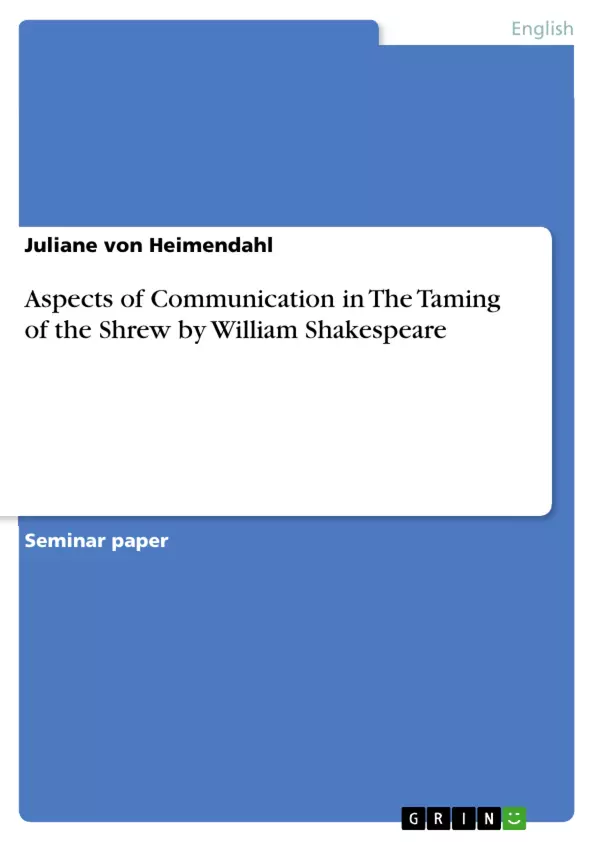In the following I am going to approach Shakespeare’s „The Taming of the Shrew,“ by analyzing selected dialogues according to their communication patterns. Main focus here is it to look at relationship and gender structures and their manifestations. The question raised is whether language is specifically used to affirm
polarities, or even if these polarities are only a result of defining language. To what extent is reality constructed through this language and for what reason? What positions do non-verbal communication signs, such as clothes and body-language
have, and do they influence the interaction as well?
Working with a text always brings up questions and conclusions that may be subjective and just one possible interpretation. I have tried to show different approaches and have backed up my analysis with studies in communication sciences such as works by Watzlawick and Schultz von Thun. The main axiom on which I base this paper on is: “All behaviour is communication.” I am going to present different aspects of language to picture communication as a
whole, as a system with various elements, supporting each other.
Inhaltsverzeichnis (Table of Contents)
- Introduction
- Question of identity
- Basis
- Language creates categories
- Non-verbal communication through costume
- Figures of speech as communication
- Communication and power struggle
- Basis
- Battle for definitions (Act IV, Scene I)
- Taming the falcon (Act IV, Scenes I-III)
- Submission? (Act IV, Scene V)
- Conclusion
Zielsetzung und Themenschwerpunkte (Objectives and Key Themes)
This paper examines Shakespeare's "The Taming of the Shrew" by analyzing selected dialogues and their communication patterns. The study aims to understand the relationship and gender structures present in the play and their manifestations. It explores whether language is used to affirm polarities or if these polarities are a result of language itself. Furthermore, it investigates the extent to which reality is constructed through language and the reasons behind it. The paper also examines the role of non-verbal communication signs, such as clothes and body language, in influencing the interaction.
- The interplay between language and identity
- The construction of gender roles and societal expectations
- The impact of communication on power dynamics
- The use of verbal and non-verbal communication strategies
- The manipulation and subversion of language in social interaction
Zusammenfassung der Kapitel (Chapter Summaries)
The introduction sets the stage for the analysis by outlining the central question of the paper: how communication patterns in "The Taming of the Shrew" reflect and shape relationship and gender structures. The first chapter delves into the concept of identity, exploring how language influences behavior and creates cognitive categories. It examines the title and character of Katherina, arguing that her “shrewish” nature is defined by her language and its deviation from societal expectations. The second chapter dives deeper into the power of language, exploring how it creates categories and oppositions, ultimately influencing the perception and treatment of individuals like Katherina and Bianca.
Schlüsselwörter (Keywords)
The key themes explored in this paper are communication, language, identity, gender, power, relationships, and social structures. It examines the influence of language on social interaction, particularly in the context of Shakespeare's "The Taming of the Shrew." The analysis uses concepts from communication sciences, drawing on theories from Watzlawick, Schultz von Thun, and Saussure.
- Citar trabajo
- Juliane von Heimendahl (Autor), 2001, Aspects of Communication in The Taming of the Shrew by William Shakespeare, Múnich, GRIN Verlag, https://www.grin.com/document/9166



